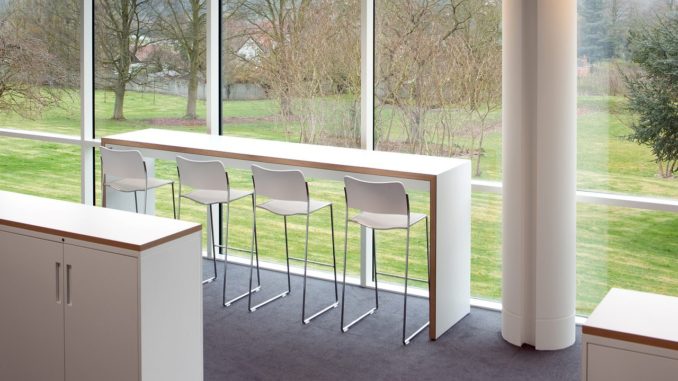
Today is ‘on your feet’ day, a day which encourages workers to #sitless and #movemore. In this article Betsey Banker, wellness educator at Ergotron, explains the part office furniture plays in worker well-being.
Imagine you walk into your office tomorrow and are handed a PC from the last decade and a phone which struggles to access the internet and has no photo, video or app capabilities. Total chaos would ensue, right? For those that can barely wait ten seconds for a web page to load, this situation would have you seriously questioning your ability to get things done.
The same can’t be said for office furniture. Sadly, we haven’t started looking at our office furniture, and in particular the humble chair and desk that most of us have to use, as having a direct link to health and productivity. This is despite numerous studies showing that being deskbound is bad for us. If you were to walk in tomorrow to a transformed office where you were handed a sit-stand workstation, research tells us you would likely be anywhere from 12 percent to 45 percent more productive. Instead, millions of workers the world over continue to work in an outdated way.
Put simply, for many of today’s corporate workers, working longer and longer hours, their office environment (and specifically the furniture they use), is contributing to a drastic increase in inactivity. The ripple effect of sedentary behaviour impacts engagement and performance, as well as short and long-term health. The World Health Organisation cites physical inactivity as the fourth biggest threat to global mortality. In fact, for the first time death from lifestyle related diseases has overtaken death caused by infectious diseases. Heart disease. Diabetes. Breast and colon cancers. Incidences of these killer diseases are all significantly increased by physical inactivity. And inactivity also affects the muscular skeletal system – excessive sitting is strongly associated with back and neck pain – and even impacts our mental health and mood state with studies showing that more than six hours of sitting can increase the risk for anxiety and depression.
These statistics lend validity to why office space planning and working methods should encourage movement. Research about non-exercise activity thermogenesis (NEAT) supports the same; the only way to meet daily energy expenditure requirements for low-level physical activity is with an active work style. When we talk about physical activity, people automatically think about exercise, but we need to focus on non-exercise physical activity in the workplace—like standing up, stretching or walking around. This is where good office design and solutions like sit-stand desks can make a huge difference. Give employees alternatives to sitting at a desk for hours on end. Movement is key, and to be fair, sitting isn’t all bad; it’s a good temporary resting posture. It’s recuperative. The problem is that sitting has now become the default posture which has led to sitting for extended periods of time. Our workplaces need to encourage frequent postural rotation, switching between sitting to standing to sitting, to fully realize the benefits of non-exercise activity.
It’s time to change how we are physically asked to work and addressing outdated furniture is the first step.
The furniture in our workplaces has a direct influence on levels of activity. It’s helpful to think about inactivity in two ways: forced and voluntary. Currently, many of our workplaces are designed with furniture that forces inactivity throughout the day, whether at an individual workstation or in conference rooms. As the forced behaviour becomes habit, it leads to more inactivity after work. Think of your metabolism like a battery; movement charges that battery and inactivity drains it. If you drain your battery at work by sitting for eight hours, you arrive home with less “juice” to do other beneficial activities. But if you change your work space to encourage movement (by introducing workspaces that allow you to sit and stand intermittently), you can gradually charge your battery over the course of the whole day. Collectively, it’s this reduction in sedentary behaviour, by creating choice where it didn’t formerly exist and adopting new habits, that reduces our risk of physical and mental health disorders, feeding back into the positive cycle.
Given the inherent dangers associated with long periods of sitting, are office workers prepared to change how they work and use innovations like sit-stand desks? In 2016, Ergotron carried out a survey entitled the ‘Workplace Movement Assessment’ which found that:
- 95 percent agreed that having access to sit-stand furniture led to an increased amount of time spent standing
- 80 percent said that they got an extra one-plus hours of low level physical activity (LLPA) per day.
These stats are important because even one hour of reduced sitting time is enough to have a positive impact on the emotional state. A study published in Centers for Disease Control & Prevention showed that 100 percent of participants experienced a positive impact to mood state after using a sit-stand desk, with many citing increased levels of productivity, energy, focus and happiness.
But even if the method is proven to be effective in helping employees reduce sedentary time, is everyone ready for it?
The case for changing the office environment is a clear cut one; by introducing more active working styles through good office design and innovative sit-stand desk solutions, you can drive real behaviour change in a way that positively impacts individuals and organisations. It’s time to make access to modern office furniture and movement-inspired designs as ubiquitous as the latest technology. Making these changes is conducive to the kind of enhanced productivity, wellness and job satisfaction that businesses seek for their financial success.
If you were to walk into your office tomorrow, what scenario would you prefer seeing? If you crave an active work environment, here’s a challenge. Visit Juststand.org and find some tools to share with your boss or leadership teams. You can be the catalyst for change.

Be the first to comment